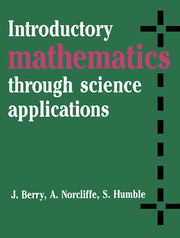Book contents
- Frontmatter
- Contents
- Preface
- 1 Basic functions
- 2 Functions for science 1: the exponential function
- 3 Functions for science 2: trigonometric functions
- 4 Functions for science 3: inverse functions
- 5 Other functions of science
- 6 Differentiation 1: rates of change
- 7 Differentiation 2: stationary points
- 8 Differentiation 3: approximation of functions
- 9 Integration 1: introduction and standard forms
- 10 Integration 2: techniques of integration
- 11 Integration 3: further techniques
- 12 First-order ordinary differential equations
- 13 Second-order ordinary differential equations
- 14 Statistics 1: frequency distributions and associated measures
- 15 Statistics 2: probability and probability distributions
- 16 Statistics 3: sampling, sampling distributions and hypothesis testing
- 17 Partial differentiation 1: introduction
- 18 Partial differentiation 2: stationary points
- Answers to the exercises
- Index
5 - Other functions of science
Published online by Cambridge University Press: 05 June 2012
- Frontmatter
- Contents
- Preface
- 1 Basic functions
- 2 Functions for science 1: the exponential function
- 3 Functions for science 2: trigonometric functions
- 4 Functions for science 3: inverse functions
- 5 Other functions of science
- 6 Differentiation 1: rates of change
- 7 Differentiation 2: stationary points
- 8 Differentiation 3: approximation of functions
- 9 Integration 1: introduction and standard forms
- 10 Integration 2: techniques of integration
- 11 Integration 3: further techniques
- 12 First-order ordinary differential equations
- 13 Second-order ordinary differential equations
- 14 Statistics 1: frequency distributions and associated measures
- 15 Statistics 2: probability and probability distributions
- 16 Statistics 3: sampling, sampling distributions and hypothesis testing
- 17 Partial differentiation 1: introduction
- 18 Partial differentiation 2: stationary points
- Answers to the exercises
- Index
Summary
Scientific context
In the first four chapters we have introduced various important functions and investigated their properties. In the last chapter we presented some of the more formal aspects of the properties of a function, such as its domain and image, and considered how to build up composite functions by combining basic functions. In this chapter we continue to investigate the properties of functions and introduce one more important function namely the function f(x) = 1/x.
Example 1: equations of state. Pure substances can exist in various phases, namely gas, liquid and solid, and whether the phase is a gas, a liquid or a solid is determined essentially by the values of the pressure, volume and temperature of the substance. Relationships between p, V and T lead to different models called equations of state. To investigate these models fully we obviously need to understand the properties of functions of more than one variable. Functions of several variables are discussed in Chapter 17, but to simplify matters, suppose we look at the changes that can take place in a substance when the temperature remains constant. (Such changes are called isothermal changes.)
Imagine then that an experiment is carried out where the volume of gas is measured at different pressures, the temperature remaining constant. Suppose the results of the experiment are those shown in Table 5.1. In a first attempt to produce a model we might plot a graph of the pressure against the volume, as shown in Fig. 5.1.
- Type
- Chapter
- Information
- Introductory Mathematics through Science Applications , pp. 132 - 158Publisher: Cambridge University PressPrint publication year: 1989



